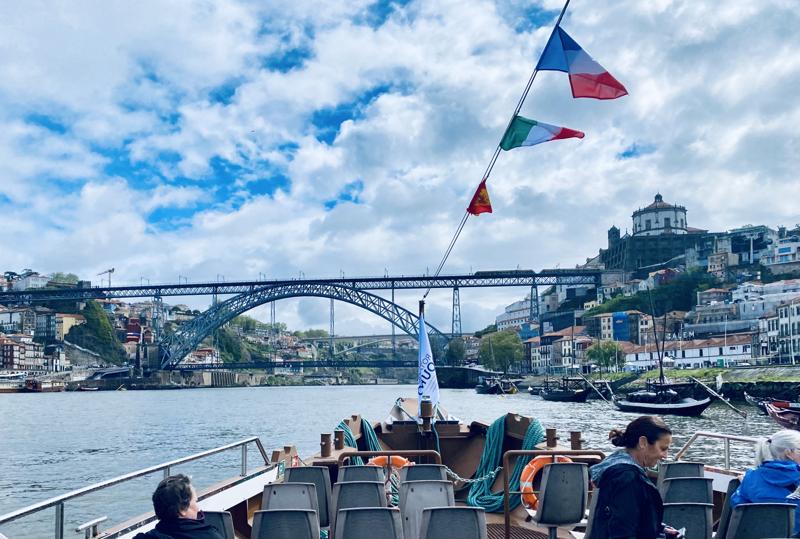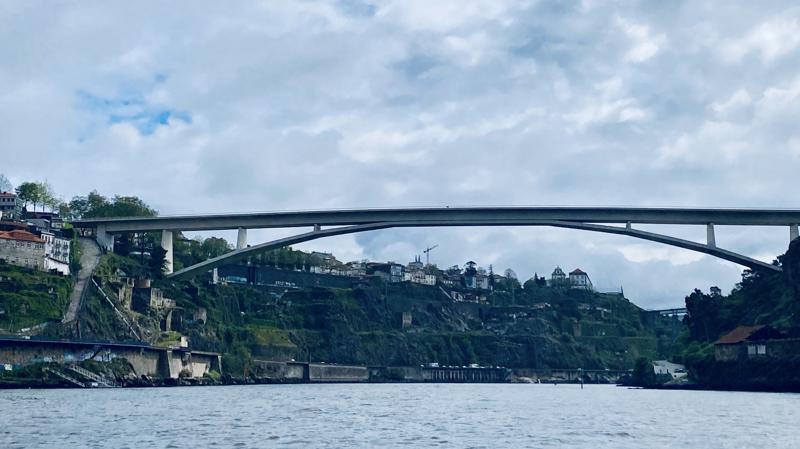Six Bridges Douro River Cruise
Written By: Gail Clifford | Published By: Weekend Notes | August 14, 2024
A River Tale from Porto, Portugal

The Six Bridges Douro River Cruise Boat and Luis I
Porto, Portugal—where every corner tells a tale, where the scent of the Atlantic mingles with the fragrance of freshly baked pastéis de nata, and where even the rain can’t dampen the spirit of adventure. On our recent escapade to this charismatic city, my daughter and I found ourselves embracing the elements as we embarked on The Six Bridges Douro River Cruise, a journey that wove us through history, architecture, and the soul of Porto itself.
The morning was draped in a misty drizzle, the kind that clings to your clothes and curls your hair into unruly waves. But as seasoned travelers, we saw the rain not as a deterrent but as an added layer of atmosphere—what better way to explore Porto’s riverbanks than with the moody ambiance of a rainy day? Armed with raincoats and a sense of adventure, we walked across the Luís I bridge to the Gaia side of the river, down the waterfront, and boarded the traditional Rabelo boat, once used for transporting barrels of port wine down the Douro River. This wasn’t just any boat ride; it was a passage through time, carried by the currents that have shaped Porto and Vila Nova de Gaia.
The cruise began in the heart of Porto, a UNESCO World Heritage Site where history whispers from every cobblestone. The first bridge we passed under was the iconic Dom Luís I, its double-decked iron structure a testament to the engineering prowess of the late 19th century. With the boat gliding beneath, I couldn’t help but marvel at how the bridge has connected not just two sides of a river, but two distinct identities—Porto, with its bustling streets and historic charm, and Vila Nova de Gaia, the gateway to the world of port wine and sardines. Our tour guide told us it’s not really known as “Dom Luís I” because he didn’t show up for the ceremonial opening, so “Luís I” it will always be to us.
As the rain drummed softly on the boat’s roof and open seating, the guide’s voice echoed over the speakers, narrating the story of each bridge in five to six languages, one sentence at a time. It was an almost hypnotic experience—words blending into the rhythm of the river, the same story retold in different tongues, emphasizing the universality of Porto’s heritage.
We passed under the sleek, modern lines of the Infante Bridge, the imposing arches of the Arrábida Bridge, and the nostalgic elegance of the Maria Pia Bridge, a relic of Gustave Eiffel’s genius before his more famous tower in Paris.

Ponte Infante Dom Henrique
The Infante Bridge (Ponte Infante Dom Henrique), inaugurated in 2003, stands as a symbol of modernity and progress in Porto. Named after the famed Portuguese prince, Henry the Navigator, this bridge was constructed to alleviate traffic on the nearby Luís I Bridge. It spans 371 meters (1,217 feet) with a clean, minimalist design, making it a stark contrast to the older, more ornate bridges nearby. The Infante Bridge holds the distinction of being the longest concrete arch bridge in the world at the time of its completion and embodies the harmony between form and function in contemporary engineering. It’s as if the bridge itself whispered, “Look at me, I’m not just functional—I’m fabulous!”

Ponte da Arrabida Porto
The Arrábida Bridge (Ponte da Arrábida), completed in 1963, was once the longest concrete arch bridge in the world, with a span of 270 meters (886 feet). Designed by the renowned Portuguese engineer Edgar Cardoso, the bridge is a marvel of mid-20th-century engineering, connecting the city center of Porto with the western districts. Its impressive arches, rising gracefully over the Douro River, were a groundbreaking achievement in their time and continue to inspire awe today. The bridge’s construction was a testament to Portugal’s engineering capabilities and played a crucial role in the development of the city’s infrastructure, easing the flow of traffic and contributing to Porto’s urban expansion.
Bridges have other associated urban myths and legends, sometimes dark. Our tour guide mentioned the bridge associated with a serial killer in Porto is the Arrábida Bridge (Ponte da Arrábida).
This connection comes from the case of Diogo Alves, one of Portugal’s most infamous criminals in the 19th century. Though often associated with the Aqueduto das Águas Livres in Lisbon, Alves’ crimes involved pushing his victims from heights after robbing them, which led to his reputation as a serial killer who operated on bridges.
While not directly tied to the Arrábida Bridge itself, the idea of bridges as sites for such grim events in Portuguese history often leads to a connection with the theme of serial killers. However, there is no concrete historical event specifically linking the Arrábida Bridge to a serial killer, but the bridge does invoke the macabre stories of criminals like Diogo Alves due to its prominence as a significant and towering structure in Porto.
The mix-up or confusion sometimes arises in popular culture or folklore, where the association of notorious criminals with famous bridges or aqueducts in Portugal becomes exaggerated or misattributed.
Gail Clifford
Latest posts by Gail Clifford (see all)
- We Were Warned: An Anthology of Short Stories - October 23, 2024
- Exploring Dublin’s Royal Canal: A Journey Through Time and Nature - September 30, 2024
- The 8 Best Dr. Phillips Restaurants | Dr. Phillips, West Orlando, Florida - September 19, 2024
- Discover Cascais, Portugal - September 18, 2024
- The Ultimate Expat Guide How to Buy Property in Costa Rica, Ireland and the USA With Less Stress - September 17, 2024

0 Comments